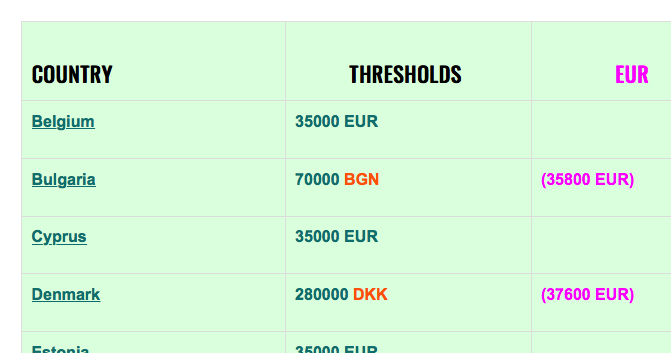Thresholds for distance selling within the EU. What limits apply to the sale of goods to private individuals abroad? When do you have to register for VAT in another EU country? Where is the table with updated thresholds for 2019? How much can you sell before you have to register for VAT in the land of destination? Distance selling thresholds EU? What does the destination principle mean?
Thresholds for Distance Sales
If you sell goods (VAT excluded) for a value higher than the amount shown in this table, you will have to register for VAT in that country. Click on the country name to access a page with detailed VAT information for each state:
COUNTRY | THRESHOLDS | EUR | SEK |
35000 EUR | 358600 | ||
70000 BGN | (35800 EUR) | 366800 | |
35000 EUR | 358600 | ||
280000 DKK | (37600 EUR) | 364800 | |
35000 EUR | 358600 | ||
35000 EUR | 358600 | ||
35000 EUR | 358600 | ||
35000 EUR | 358600 | ||
35000 EUR | 358600 | ||
35000 EUR | 358600 | ||
270000 HRK | (36400 EUR) | 362700 | |
35000 EUR | 358600 | ||
35000 EUR | 358600 | ||
100000 EUR | 1024500 | ||
35000 EUR | 358600 | ||
100000 EUR | 1024500 | ||
160000 PLN | (37300 EUR) | 382200 | |
35000 EUR | 358600 | ||
118000 RON | (25300 EUR) | 259200 | |
35000 EUR | 358600 | ||
35000 EUR | 358600 | ||
35000 EUR | 358600 | ||
70000 GBP | (78500 EUR) | 804300 | |
320000 SEK | (31300 EUR) | 320000 | |
1140000 CZK | (44600 EUR) | 457000 | |
100000 EUR | 1024500 | ||
35000 EUR | (27400 EUR) | 280700 | |
35000 EUR | 358600 |
Source: Momsens.se. Table updated 30 JUNE 2020.
Do you think it’s cumbersome to handle VAT when selling to other countries? Yes, it is! If you are going to manage this by yourself today, I must congratulate you on your two new full-time jobs, not including running your own company. But now there is finally a solution to this bureaucratic nightmare. Read more here.
Remember to check if the customer you are selling to is really within the EU VAT area. Some parts that are part of the EU are outside the EU VAT area (eg Åland, which is part of Finland but which is outside the EU VAT area) and other regions and non-EU regions are considered to be within the EU-VAT-area (e.g. Monaco, which is considered to be in France concerning VAT matters).
Learn more about how the EU VAT area is defined here
Distribution sales within the EU
Distance selling means that if you are selling a product from, as an example, Sweden. Then it is transported from Sweden to a private customer in another EU country. You then sell with Swedish VAT from the beginning, but if you sell a lot, you will have to register for VAT in each country you cross the limit in (threshold value in the table above), and then you will have to manage the sales as if you had a store in that country – from a VAT perspective. That means filling out VAT declaration forms and getting an EU-VAT number in that country etc.
Example:
You own the website coolthings.se which you have translated into some of the most significant languages in the EU. Now you start to get a lot of orders from France.
Let’s assume you have sold for 300000 SEK (excluding VAT) and start thinking about the VAT-effects from this turnover. You have sold with Swedish VAT to French customers so far. The amount 300K SEK corresponds approximately to 31300 Euro, and in the table, you see that you can sell up to 35000 Euro to French private customers before you need to register for VAT in France and submit French VAT declarations (time to start French, so you understand the VAT declaration form?).
The success continues, and you have now sold for 330K SEK, which means approximately 35460 EUR. You have now passed the distance selling threshold. This means that you should instead apply the Destination Principle for VAT. The 460 EUR (35460–35000) above the threshold should now be reported as sales in France with French VAT. Formally, you must credit the last incorrect invoices that have Swedish VAT and re-state them with French VAT from now on instead. The last items you sold were different electronics gadgets that have 20% VAT in France but 25% VAT in Sweden. You have charged 5% too much of the amount of VAT on the last 460 EUR in sales, which will now be pure profit for you and you only pay 20% of EUR 460 in the French VAT declaration to the French Tax Authorities. All future sales must be made with France VAT from now on. Imagine the administrative nightmare this creates for smaller businesses.
The Swedish Tax Authorities should not receive any sales tax (VAT) above the threshold of EUR 35000. However, you will be taxed on the company’s profit at a rate of 100% in Sweden, unless you open a branch or separate company in France to handle the sales there locally.
Read more about the transition to the DESTINATION PRINCIPLE IN EU here
Destination principle for VAT
Within the EU, the destination principle for VAT means that VAT is taken in the recipient’s country. The sale is then considered to be sold in the country in which the customer resides. This principle is, sadly, already used for digital services. The EU plans to introduce the same principles for goods, which would be a total disaster for Europe’s economy and small business owners, but it is a bit too advanced for the fishmongers in Brussels to understand this. No assessments of the impacts are really made to investigate which effects this change would have in practice, neither for administration nor the accounting issues. The only thing that is on the table is trying to resolve the VAT carousel fraud, which is due to a completely insane VAT system from the outset.
VAT is something you can have on domestic goods, possibly on domestic services. But dealing with different VAT circuses between countries within the Union will only result in total chaos and it simply does not work. It doesn’t matter how many times you try to fix a broken system with broken solutions, the end result will always be a broken system. If you feed shit into a system that is in itself corrupted the only output you will get is PURE CRAP, and that is exactly what is happening, and will happen, even more in the future within the European Union…
The only thing that would solve the problem is the introduction of import VAT for goods crossing a national border, but it is POLITICAL SUICIDE since it implies the ‘free movement of goods’ within the Union has ceased to exist. The solution is thus for the countries to return to national sovereign states outside the union, or a full integration and harmonisation with the same VAT and tax systems throughout the EU, where countries are denied VAT collection at a national level, which will never happen..
The second solution for individual companies is to base themselves outside the EU. It is, therefore, the definition of catch 22. This does not look too bright for Europe’s economy and entrepreneurship.
Have they thought about the administrative nightmare this creates for small business owners? Of course not, the bureaucrats in Brussels never realised anyone who sells goods online now has to keep track of VAT rates for all EU countries and adapt their invoices and VAT rates depending on the country in which THE CUSTOMER is situated. This will yield the same result as the introduction of the destination principle for digital services, i.e., small businesses stop selling to private customers in the EU!
Should this principle be introduced for B2B transactions (today VAT-free because of reverse charge principle), Europe will halt entirely, and then there will be no tax revenue at all for the EU bureaucracy…
No economic activity = no tax.
How difficult can it be to understand this EU politicians?
So now it’s time European companies start preparing for the destination principle or lobby to leave the union, or as a last resort move your company outside the EU.
VAT rates for digital services in EU countries
Exemptions from the EU VAT area






Pingback: VAT News 2021 - Accounting & Finance blog